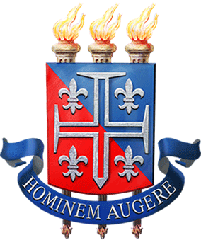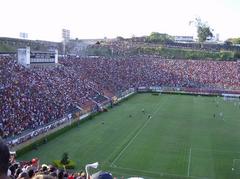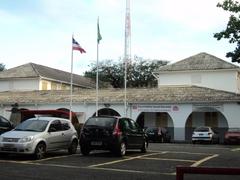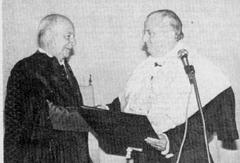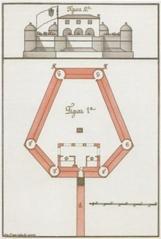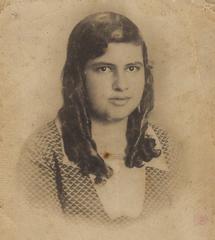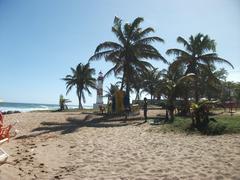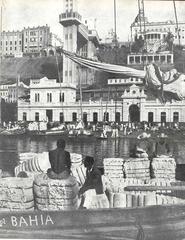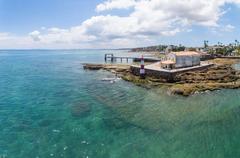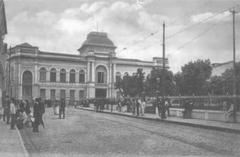Museum of Brazilian Music: Visiting Hours, Tickets, and Salvador Historical Sites Guide
Date: 14/06/2025
Introduction
Located in the UNESCO World Heritage-listed Pelourinho district, the Museum of Brazilian Music (Museu da Música Brasileira) is a dynamic institution dedicated to showcasing and preserving the rich tapestry of Brazil’s musical heritage, with special emphasis on Salvador’s Afro-Brazilian roots. This museum is not just a repository of artifacts, but a vibrant hub for education, community engagement, and artistic innovation. Its exhibits, workshops, and live performances celebrate genres such as samba, axé, and tropicalismo, all of which are deeply entwined with the history and multicultural identity of Salvador (UNESCO Cities of Music, Virtual Museum of Lusophony, Salvador da Bahia).
This comprehensive guide covers the museum’s history, visiting hours, ticketing, accessibility, key exhibits, travel tips, and nearby attractions—giving you all the information you need for an unforgettable visit to Salvador’s musical heart.
Table of Contents
- Historical Roots of Brazilian Music in Salvador
- The Evolution of Musical Genres
- Cultural Significance of the Collections
- Visiting Hours and Ticket Information
- Accessibility
- Travel Tips
- Nearby Attractions
- Architectural Features
- Visitor Engagement and Educational Programs
- Visuals and Media
- FAQ
- Conclusion and Call to Action
- References
Historical Roots of Brazilian Music in Salvador
Salvador, Bahia’s capital, is the birthplace of iconic genres like samba, axé, and tropicalismo (UNESCO Cities of Music). Founded in 1549, Salvador’s port played a crucial role in the transatlantic slave trade, resulting in a unique blend of African, Indigenous, and European musical traditions (Virtual Museum of Lusophony). The Museum of Brazilian Music reflects this dynamic cultural legacy, with collections that highlight the fusion and evolution of these influences across centuries.
The Evolution of Musical Genres
Samba
Samba, often called the heartbeat of Brazil, developed from the gatherings of Afro-Brazilian communities and became a symbol of national identity. Salvador’s samba is rooted in resilience and cultural preservation (Brazily Fitness).
Axé
Axé music emerged in Salvador in the late 20th century, blending samba, reggae, and African rhythms. It’s closely associated with the explosive energy of Bahian Carnival, attracting millions of revelers annually (Moments Log).
Tropicalismo
The 1960s saw the birth of tropicalismo—a movement that fused traditional Brazilian sounds with international genres like rock and psychedelia. Pioneered by Bahia’s own Caetano Veloso and Gilberto Gil, it challenged artistic norms and promoted creative freedom (UNESCO Cities of Music).
Cultural Significance of the Collections
The museum’s exhibits are organized thematically and chronologically, tracing the development of indigenous music, the impact of African rhythms, and the emergence of new genres. Artifacts include indigenous and African instruments, costumes, archival recordings, and memorabilia from legendary artists.
Afro-Brazilian Heritage
A major focus is the Afro-Brazilian roots of Salvador’s music. Exhibits feature instruments like atabaques, agogôs, and berimbaus, with multimedia panels providing context and sound samples. The influence of Candomblé and its sacred music is also explored (Virtual Museum of Lusophony).
Carnival and Community
Carnival’s significance is celebrated through displays on the “trio elétrico” (mobile sound stage) and iconic groups like Olodum and Sons of Gandhi, highlighting music’s role in Salvador’s communal festivities (Virtual Museum of Lusophony).
Music as Social Commentary
The museum emphasizes music’s role in social commentary—addressing themes of identity, inequality, and cultural pride, especially through axé and samba’s stories of resistance and unity (Moments Log).
Visiting Hours and Ticket Information
- Open: Tuesday–Sunday, 10:00 AM–6:00 PM (closed Mondays and public holidays).
- Admission: About R$20–R$30 (discounts for students, seniors, and children under 12; free on the first Sunday of each month).
- Tickets: Available at the entrance or online (Museum Of Brazilian Music Official Site, WhichMuseum).
- Guided Tours: Offered in Portuguese, English, and Spanish; book ahead for thematic or private tours.
Accessibility
The museum is fully accessible, with ramps, elevators, and adapted restrooms. Tactile exhibits, braille labels, and sign language interpretation are available on request. Audio guides and multilingual resources ensure an inclusive experience for international visitors.
Travel Tips
- Combine your visit with a walking tour of Pelourinho and nearby sites.
- Visit on weekdays or early hours to avoid crowds, especially during Carnival.
- Wear comfortable shoes—cobblestone streets can be uneven.
- Check the event schedule for workshops, performances, and festivals.
Nearby Attractions
- Pelourinho Square: Lively historic center with colorful facades and street performances.
- São Francisco Church and Convent: Renowned Baroque architecture.
- Elevador Lacerda: Offers panoramic views of the city.
- Mercado Modelo: Popular market for crafts and souvenirs.
- Museum of Modern Art (MAM-BA): Contemporary art in a historic setting (Bahia.ws).
- Jorge Amado House and Afro-Brasileira Museum: Explore literature and Afro-Brazilian culture.
Architectural Features
The museum is housed in a restored colonial-era building in Pelourinho, with original tiled roofs, colorful facades, and wrought-iron details (Architectural Digest). Interiors feature thematic exhibition halls, interactive displays, and accessible design upgrades.
Visitor Engagement and Educational Programs
- Interactive Zones: Try playing samba drums, berimbaus, and other instruments.
- Workshops & Masterclasses: Participate in capoeira music, songwriting, and improvisation sessions.
- Children’s Programs: Storytelling and rhythm games introduce young visitors to Brazilian music.
- Live Performances: Frequent concerts in the museum’s courtyard and auditorium, especially during festivals.
Visuals and Media
- Include images of the museum’s facade, interactive exhibits, and nearby attractions with descriptive alt text (e.g., “Museum of Brazilian Music Salvador facade”, “Traditional Afro-Brazilian instruments on display”).
- Virtual tours and interactive maps are available on the museum’s website and social media.
FAQ
Q: What are the Museum of Brazilian Music’s visiting hours?
A: Tuesday–Sunday, 10:00 AM–6:00 PM; closed Mondays.
Q: How much are tickets?
A: R$20–R$30, with discounts and free admission on the first Sunday of each month.
Q: Are guided tours available?
A: Yes, in multiple languages; book in advance for specialized tours.
Q: Is the museum accessible?
A: Fully accessible, with resources for visitors with mobility, visual, and hearing impairments.
Q: What are nearby historical sites to visit?
A: Pelourinho, Mercado Modelo, Elevador Lacerda, São Francisco Church, Jorge Amado House, and MAM-BA.
Conclusion and Call to Action
The Museum of Brazilian Music is a cultural cornerstone of Salvador, offering visitors an immersive journey into Brazil’s musical soul. Through its engaging exhibits, innovative programs, and commitment to accessibility, the museum stands at the intersection of history, creativity, and community engagement. Plan your visit by consulting the latest information on hours and ticketing, and enrich your experience by exploring Salvador’s historic center and participating in workshops or live performances.
Enhance your visit by downloading the Audiala app for personalized guided tours and updates. Explore our related articles on Salvador’s historical sites and cultural festivals, and follow us on social media for the latest news, events, and visitor tips.
References
- UNESCO Cities of Music
- Virtual Museum of Lusophony
- Salvador da Bahia
- WhichMuseum
- Brazil Blogged
- Moments Log
- I Heart Brazil
- Museum Of Brazilian Music Official Site
- Architectural Digest
- Bahia.ws
- Bel Around the World

